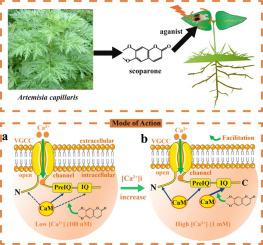Journal of Advanced Research ( IF 11.4 ) Pub Date : 2021-08-23 , DOI: 10.1016/j.jare.2021.08.013 Hong Zhou 1 , Fenglin Wan 1 , Fuyou Guo 1 , Jinlin Liu 1 , Wei Ding 1

|
Introduction
Investigation into the action mechanisms of plant secondary metabolites against pests is a vital strategy for the development of novel promising biopesticides. Scoparone (isolated from Artemisia capillaris), a renewable plant-derived bioresource, displays potent acaricidal activities against mites, but its targets of action remain unclear.
Objectives
This study aimed to systematically explore the potential molecular targets of scoparone against Tetranychus cinnabarinus and provide insights to guide the future application of scoparone as an agent for the management of agricultural mite pests worldwide.
Methods
The mechanism and potential targets of scoparone against mites were investigated using RNA-seq analysis; RNA interference (RNAi) assays; bioassays; and [Ca2+]i, pull-down and electrophysiological recording assays.
Results
RNA-seq analysis identified Ca2+ signalling pathway genes, specifically 5 calmodulin (CaM1–5) genes and 1 each of L-, T-, N-type voltage-gated Ca2+ channel (VGCC) genes, as candidate target genes for scoparone against mites. Furthermore, RNAi and electrophysiological data showed that the CaM1- and L-VGCC-mediated Ca2+ signalling pathways were activated by scoparone. Interestingly, by promoting the interaction between CaM1 and the IQ motif (a consensus CaM-binding domain of L-VGCC), CaM1 markedly enhanced the activating effect of scoparone on L-VGCC. Pull-down assays further demonstrated that CaM interacted with the IQ motif, triggering L-VGCC opening. Importantly, mutation of the IQ motif significantly weakened CaM1 binding and eliminated the CaM1-mediated enhancement of scoparone-induced L-VGCC activation, indicating that the effect of scoparone was dependent on the CaM1–IQ interaction.
Conclusion
This study demonstrates, for the first time, that the acaricidal compound scoparone targets the interface between CaM1 and L-VGCC and activates the CaM-binding site, located in the IQ motif at the L-VGCC C-terminus. This work may contribute to the development of target-specific green acaricidal compounds based on L-VGCC.
中文翻译:

可再生生物资源杀螨剂的高附加值应用:东莨菪酮对朱砂叶螨的作用机制研究
介绍
研究植物次生代谢产物对害虫的作用机制是开发有前景的新型生物农药的重要策略。Scoparone(从毛蒿中分离)是一种可再生植物来源的生物资源,对螨虫具有有效的杀螨活性,但其作用目标仍不清楚。
目标
本研究旨在系统地探索东莨菪酮对抗朱砂叶螨的潜在分子靶点,并为指导未来将东莨菪酮用作全球农业螨虫害虫管理的药剂提供见解。
方法
使用 RNA-seq 分析研究了东莨菪碱对螨虫的作用机制和潜在靶点;RNA干扰(RNAi)测定;生物测定;和[Ca 2+ ]i、下拉和电生理记录测定。
结果
RNA-seq 分析确定 Ca 2+信号通路基因,特别是 5 个钙调蛋白 (CaM1-5) 基因和 L-、T-、N 型电压门控 Ca 2+通道 (VGCC) 基因各 1 个,作为候选靶基因用于防治螨虫的scoparone。此外,RNAi 和电生理数据表明 CaM1- 和 L-VGCC 介导的 Ca 2+信号通路被东莨菪酮激活。有趣的是,通过促进 CaM1 和 IQ 基序(L-VGCC 的共有 CaM 结合域)之间的相互作用,CaM1 显着增强了东莨菪酮对 L-VGCC 的激活作用。下拉分析进一步表明,CaM 与 IQ 基序相互作用,触发 L-VGCC 开放。重要的是,IQ 基序的突变显着削弱了 CaM1 结合并消除了 CaM1 介导的 scoparone 诱导的 L-VGCC 活化增强,表明 scoparone 的作用取决于 CaM1-IQ 相互作用。
结论
这项研究首次证明,杀螨化合物scoparone 靶向CaM1 和L-VGCC 之间的界面并激活位于L-VGCC C 末端IQ 基序中的CaM 结合位点。这项工作可能有助于开发基于 L-VGCC 的目标特异性绿色杀螨化合物。









































 京公网安备 11010802027423号
京公网安备 11010802027423号